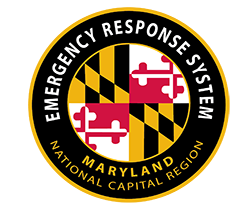As a subrecipient of the National Capital Region’s (NCR) Urban Area Security Initiative (UASI) award, the Maryland-National Capital Region Emergency Response System (MDERS) complies with federal regulations for grant-funded projects. One such regulation is the Federal Emergency Management Agency’s (FEMA) Environmental and Historical Preservation (EHP) review process. The EHP review process aims to minimize the impacts of any project on the environment and historically designated sites, including floodplains, wetlands, archeological sites, historic structures, protected coastal areas, critical wildlife habitats, clean air and water, and minority and low-income populations among others. In order to ensure the long-term preservation of these sites, any project that could cause permanent impacts must be approved by FEMA through the EHP process.
MDERS, in its support of emergency response partners across Prince George’s and Montgomery Counties, supports numerous projects that fall under the jurisdiction of the EHP review process. Notably, any building modification, including the permanent installation of equipment, must be approved by FEMA. In addition to building modifications, any training opportunity that occurs in a non-designated training facility, as defined by the local agencies, requires FEMA EHP approval to ensure no damage or permanent impacts will be made to the training site. As the single point of collaboration on multi-disciplinary, multi-jurisdiction emergency response capability enhancement, MDERS manages the EHP review process on behalf of its stakeholders.
The required application includes a FEMA-provided questionnaire that defines the scope of the project in question. The FEMA screening form prompts users to provide a variety of information including grant project names, contact information, estimated cost, project description, and the intended construction to be conducted on the building. Additionally, the screening form must be accompanied by secondary photo documentation. The required photos must include a picture of the structure and if possible, a building sign. This preliminary information is sufficient in most cases but, FEMA requires additional photo documentation for building over 45 years old, as older buildings are more closely associated with potential environmental concerns and an enduring historical significance. The extra photos must clearly identify the area(s) that any alteration to the building will occur so that FEMA can closely assess the environmental and historical ramifications of the specific areas of construction.
Within the MDERS portfolio, the Public Access Trauma Care (PATC) program is most intertwined with the EHP process. As part of the PATC program, MDERS works closely with both Prince George’s and Montgomery Counties to install readily accessible bleeding control kits and medical supplies in public schools and government buildings. These items are stored in PATC cabinets, which are permanently affixed to interior walls similarly to fire extinguishers or automated-external defibrillators (AEDs). Before these cabinets are installed, MDERS must submit the required EHP documentation to ensure that any alteration to a building does not harm the environment and protects its historical significance.
MDERS began the EHP process for the PATC program by coordinating with stakeholders to determine how many buildings would be impacted and their respective ages. By delineating buildings by age, MDERS determined which buildings required additional photo documentation and which did not. MDERS then worked closely with subrecipients to identify the strategic location of PATC kits and cabinets, conduct the needed photography, and compile the information for submission to FEMA for approval.
 To better meet the needs of its stakeholders, MDERS developed an EHP checklist for the PATC program. This checklist not only provided all the necessary information to FEMA, but also served as a resource to stakeholders to refer back to for the ultimate installation of the PATC cabinets.
To better meet the needs of its stakeholders, MDERS developed an EHP checklist for the PATC program. This checklist not only provided all the necessary information to FEMA, but also served as a resource to stakeholders to refer back to for the ultimate installation of the PATC cabinets.
While the EHP process can appear daunting, MDERS is committed to helping its stakeholders through the FEMA review process and ensure that projects are executed in accordance with the Maryland-National Capital Region’s needs and in compliance with federal regulations.
For more information on the EHP review process, please visit: https://www.fema.gov/grants/guidance-tools/environmental-historic.





 MDERS partnered with MCPS to configure the training kits to best meet the needs of Montgomery County high schools. To ensure students are prepared to deploy a PATC kit in a real-world situation, each training kit contains a variety of equipment mirroring the supplies an individual may find in the PATC kits installed throughout MCPS. Each high school received three training kits comprised of the following supplies:
MDERS partnered with MCPS to configure the training kits to best meet the needs of Montgomery County high schools. To ensure students are prepared to deploy a PATC kit in a real-world situation, each training kit contains a variety of equipment mirroring the supplies an individual may find in the PATC kits installed throughout MCPS. Each high school received three training kits comprised of the following supplies: